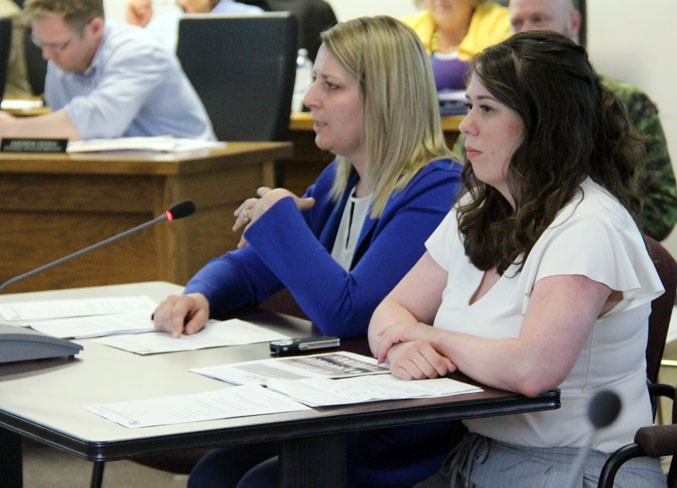Keeping an eye on air quality throughout the region is a top priority for the Lakeland Industry and Community Association (LICA), and it's about to get more enlightening.
Erin Ritchie, manager of environmental programs for LICA, was ecstatic to announce to the City of Cold Lake a new program coming to their organization.
“What I’m very excited about is the lantern. It’s an air quality health index lantern. Inside of these lanterns are special light bulbs that change colour based on the quality of the air,” she explained to council during their Tuesday, May 14 meeting.
“If it’s blue, that means the air quality is good. If it’s yellow and you’re pregnant, a senior, or you have asthma, maybe you should be more cautious, and if it turns red, almost everyone should be staying indoors,” outlined Ritchie.
These lanterns are set up in community spaces to educate the public on the quality of air within their region.
“These lanterns also have accompanying poster boards that explain the air quality health index and where they can get more information. There’s also an app you can download so you can get the information wherever you go,” added Arianne Crook, executive director for LICA.
The data is collected from one of LICA's air quality stations.
The Cold Lake system is located near the Lakeland Humane Society, while Bonnyville's is near Jessie Lake.
Currently, LICA has two lanterns in their future.
One is confirmed at the Bonnyville C2, with an agreement in the works for the Cold Lake Energy Centre.
“Imperial Oil is also looking at putting a lantern in their head offices here in Cold Lake, because it promotes the air quality in our region. It’s really taking off as a fun project,” noted Crook.
In total, LICA has four continuous air quality monitoring stations that are working 24-hours a day, seven days a week.
Aside from the ones in Cold Lake and Bonnyville, they also have systems at Imperial Oil and in St. Lina.
Imperial Oil, Crook said, gives LICA a look at the industrial-side of air quality, while St. Lina, a less populated area, "is more of a baseline."
“The continuous air monitoring stations report on the air quality health index… Any health advisories that come out during wildfire season or any kind of air quality event, that data comes from us,” she continued, adding LICA also has 26 passive monitoring systems.
"Those are just little filters that are in a plastic housing units mounted to fence posts all around the LICA region. For an entire month, they collect different samples and those are analyzed. It’s more of a long-term trend analysis."
Air quality, however, is just one of the priorities of LICA.
“The three main focus areas of our organization are environmental monitoring. Currently, the bulk of our monitoring programs are air quality-related, but we did put in a proposal to the oil sands monitoring program to do a creek water testing program in the Beaver River Watershed. We’re waiting to hear back from that,” Crook detailed. “We also have environmental management programs, which the bulk of that is our watershed management."
Projects they've been working on are the restoration of Jessie Lake, which has included air quality monitoring, lakeshore cleanups, and planting along the riparian area.
LICA also samples soils for acid deposition, and works with the Alberta Lake Management Society (ALMS) program that monitors 10 lakes within the region by sampling them five times throughout the summer.
“We look at the pH, oxygen levels, the water and if there are any invasive species, and the metals. All of these reports are on the ALMS or LICA website,” Ritchie explained.
Education and outreach is another big part of what LICA does, Ritchie noted.
“We do a lot of various types of activities, trying to reach a lot of different types of people,” she detailed. “A lot of our education outreach programs are for free. We don’t want them to be limiting to any person on whether or not they can learn about their environment."
This includes work with local schools through programs like the Stream of Dreams, X-Stream Science, Little Green Thumbs, and Clean Air Responsible Schools.
Ritchie described how their collaboration with the Muriel Lake Watershed Society is determining whether the lake is ready to be restocked.
“They’re hoping that one day, with an increased amount of water in Muriel Lake, they can repopulate or stock the lake with fish again and support a fish population. They used our equipment, we gave them training on how to collect that data, and they came and picked up the supplies,” she added. “We calibrated the device together and went out to collect the samples. We wrote up a report for them of a summary of the data they collected overall, and there’s not enough oxygen right now for fish in the winter… but, they’re still hopeful for future years."
Ritchie also touched on their new beaver deceiver, equipment that allows water to flow through a beaver dam without killing the animal or destroying their home.
“LICA has recently received funding to implement 10 of these within our watershed. Where? We don’t know yet," said Ritchie.
This is one of those cases where "partnerships are key," Crook added.
"It’s hard for us to get out and into the communities to identify the best locations to put these in."



